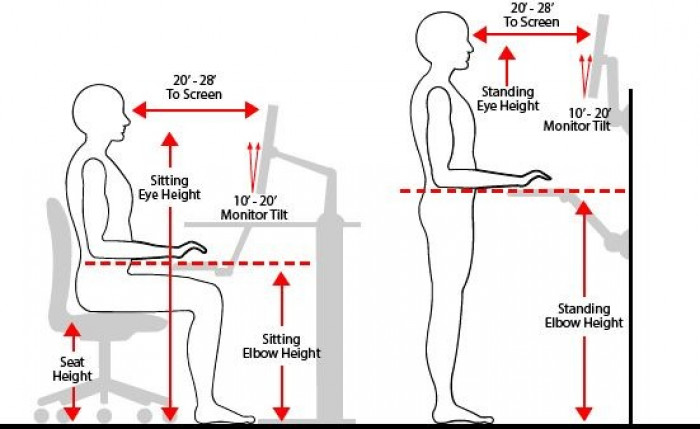
In the hustle and bustle of modern life, we often find ourselves glued to our desks, hunched over screens, or straining our necks to readjust. These habits can lead to discomfort, fatigue, and even long-term health issues. This is where the importance of postural ergonomics comes into play. In this guide, we'll delve into what postural ergonomics is, why it matters, and how you can implement it to enhance your well-being.
Understanding Postural Ergonomics
Postural ergonomics is the science of designing the environment to facilitate proper posture, reducing stress and strain on the body. It involves the arrangement of furniture, equipment, and workspaces in a way that promotes comfort and efficiency. By adopting good postural habits, you can prevent musculoskeletal disorders and increase productivity.
The Impact of Poor Posture
Before delving into the intricacies of postural ergonomics, it's crucial to understand the consequences of poor posture. Prolonged periods of slouching or improper positioning can lead to a range of health issues, including:
Muscle Strain: Incorrect posture puts undue stress on muscles, leading to discomfort and fatigue.
Spinal Misalignment: Continuous poor posture can cause the spine to deviate from its natural alignment, resulting in chronic pain.
Reduced Lung Capacity: Hunched posture restricts lung expansion, potentially leading to respiratory problems.
Headaches and Migraines: Tension in the neck and shoulders can trigger headaches and migraines.
Digestive Issues: Slumping can compress the digestive organs, potentially leading to problems like acid reflux.
Ergonomic Principles for a Healthy Posture
Optimal Desk Setup
Begin with your workspace. Ensure your desk is at a height that allows your elbows to rest at a 90-degree angle when typing. Your computer screen should be at eye level to prevent straining your neck downwards.
Chair Selection and Adjustment
Invest in an ergonomic chair that provides adequate lumbar support. Adjust the chair height so that your feet rest flat on the ground, and your knees form a 90-degree angle. Avoid sitting on the edge of the seat, as it can lead to slouching.
Keyboard and Mouse Positioning
Position your keyboard and mouse close enough so that your elbows remain bent at a comfortable angle. Keep your wrists straight to prevent strain.
Monitor Placement
The monitor should be directly in front of you, about an arm's length away. The top of the screen should align with your eye level.
Regular Breaks and Movement
Avoid staying in one position for extended periods. Take short breaks to stretch and move around. Simple exercises like neck rolls, shoulder shrugs, and torso twists can alleviate stiffness.
Integrating Postural Ergonomics into Daily Life
Conscious Awareness
Maintain mindfulness about your posture throughout the day. Regularly check if you're sitting or standing in a balanced, comfortable position.
Exercise and Flexibility
Incorporate exercises and stretches that promote flexibility and core strength. Yoga, Pilates, and simple stretching routines can work wonders.
Ergonomic Accessories
Consider using accessories like lumbar pillows, footrests, and ergonomic keyboards or mice to enhance your posture and comfort.
Regular Ergonomic Evaluations
Periodically assess your workspace and habits. Make adjustments as needed to ensure continued ergonomic efficiency.
The Human Touch in Postural Ergonomics
While ergonomic principles provide a solid foundation, it's important to remember that each individual's body is unique. What works for one person might not work for another. Thus, it's crucial to listen to your body and make personalized adjustments.
Furthermore, postural ergonomics is not limited to the workspace. It extends to everyday activities like driving, exercising, and even sleeping. Being mindful of your body's alignment in all aspects of life contributes to long-term well-being.
The Role of Ergonomic Accessories
Lumbar Support
A lumbar pillow or cushion is a simple yet effective tool to maintain the natural curve of your lower back. It helps alleviate pressure on the lumbar discs, reducing the risk of lower back pain.
Footrests
A footrest is essential, especially if your feet don't comfortably touch the ground when sitting. It promotes proper blood circulation and reduces pressure on your thighs.
Ergonomic Keyboards and Mice
These specially designed keyboards and mice are contoured to fit the natural shape of your hands, reducing strain and preventing conditions like carpal tunnel syndrome.
Beyond the Workspace: Postural Ergonomics in Daily Life
Driving Ergonomics
Maintaining good posture while driving is crucial for long-term back health. Ensure your seat is adjusted to support your lower back, and position your hands at the 9 and 3 o'clock positions on the steering wheel.
Sleeping Posture
Choosing the right pillow and mattress is essential for spinal health. Your pillow should support the natural curvature of your neck, and your mattress should provide adequate support to your spine.
Exercising for Postural Health
Activities like yoga, Pilates, and strength training exercises can strengthen core muscles, which play a significant role in maintaining good posture.
Tips for Implementing Postural Ergonomics at Work
Dynamic Sitting
Shift your position regularly while sitting. Consider using a stability ball or an active sitting chair that encourages movement.
Screen Glare and Lighting
Ensure your workspace is well-lit, and position your screen to avoid glare or reflections. This reduces eye strain and helps maintain an upright posture.
Organizing Your Workstation
Keep frequently used items within arm's reach to avoid overstretching or twisting. This minimizes unnecessary strain on your muscles.
The Psychological Aspect of Postural Ergonomics
Beyond its physical benefits, postural ergonomics can positively impact your mental well-being. Maintaining an upright posture has been linked to increased confidence, reduced stress levels, and enhanced mood.
Seeking Professional Guidance
If you're struggling with persistent posture-related issues, consider consulting with a physical therapist or an ergonomics specialist. They can provide personalized recommendations and exercises tailored to your specific needs.
Advanced Postural Ergonomics Techniques
Ergonomic Assessments
Consider engaging in a professional ergonomic assessment. This involves an expert evaluating your workspace and providing personalized recommendations for optimal ergonomics.
Alternate Workstations
Implement a sit-stand workstation. This allows you to switch between sitting and standing, reducing the strain on your back and promoting better circulation.
Micro-breaks and Stretching
Incorporate micro-breaks into your work routine. Set a timer to remind yourself to stand up, stretch, and change positions every 30 minutes.
Mindfulness and Postural Awareness
Mindful Breathing
Practice mindful breathing techniques to relax your body and release tension. Deep, diaphragmatic breathing encourages a natural, relaxed posture.
Body Scan Meditation
Regularly conduct body scan meditations to tune into any areas of tension or discomfort. This heightened awareness allows you to adjust your posture proactively.
Postural Ergonomics for Specific Professions
Postural Ergonomics for Writers
Writers often spend extended periods at their desks. Consider using a document holder to position reference materials at eye level, reducing the need to constantly look down.
Healthcare Professionals
For those in healthcare, maintaining proper posture during patient care is paramount. Techniques like the neutral spine position and using adjustable equipment can help prevent strain.
The Role of Footwear
Investing in supportive, comfortable footwear is a crucial but often overlooked aspect of postural ergonomics. Wearing shoes with proper arch support can positively impact your overall posture.
Postural Ergonomics for Children and Students
Instilling good posture habits in children is essential for their long-term health. Ensure they have ergonomically designed furniture and encourage breaks for stretching and movement.
Staying Adaptable
Remember that postural needs may change over time. Factors such as age, fitness level, and medical conditions can influence what works best for your body. Regularly reassess and adjust your ergonomic setup as needed.















